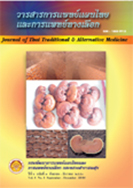Immunomodulatory Activities of Ganoderma lucidum and Spores
Main Article Content
Abstract
Ganoderma lucidum (lingzhi) is a medicinal mushroom that possesses immunomodulatory and antitumor effects. In Thailand, G. lucidum products are widely used as health-promoting agents but most of the products are imported. The aim of this study was to determine the immunomodulatory effects of various strains of G. lucidum grown in Thailand or imported. Flow cytometric measurement of early activation molecule CD69 expression on T lymphocytes showed that the water extract and water-insoluble fraction of unbroken spores of G. lucidum strain G9 (imported from China) at 100 μg/ml concentration gave the highest T lymphocytes proliferative responses, while the Thai-grown strain G2 could induce only 50 percent responses when compared with G9. The results from this preliminary study can be used in decision-making for G. lucidum strain selection and development in Thailand.
Article Details
References
2. Muller C, Kumagai T, OûKelly J, Seeram NP, Heber D, Koeffler HP. Ganoderma lucidum causes apoptosis in leukemia, lymphoma and multiple myeloma cells. Leuk Res 2006;30:841-8.
3. Hong KJ, Dunn DM, Shen CL, Pence BC. Effects of Ganoderma lucidum on apoptotic and anti-inflammatory function in HT-29 human colonic carcinoma cells. Phytother Res 2004;18:768-80.
4. Jiang J, Slivova V, Harvey K, Valachovicova T, Sliva D. Ganoderma lucidum suppresses growth of breast cancer cells through the inhibition of Akt/NF-kappaB signaling. Nutr Cancer 2004;49:209-16.
5. Cao QZ, Lin ZB. Ganoderma lucidum polysaccharides peptide inhibits the growth of vascular endothelial cell and the induction of VEGF in human lung cancer cell. Life Sci 2006;78:1457-63.
6. Kino K, Yamashita A, Yamaoka K, Watanabe J, Tanaka S, Ko K, et al. Isolation and characterization of a new immunomodulatory protein, ling zhi-8 (LZ-8), from Ganoderma lucidium. J Biol Chem 1989;264:472-8.
7. Kimura Y, Taniguchi M, Baba K. Antitumor and antimetastatic effects on liver of triterpenoid fractions of Ganoderma lucidum: mechanism of action and isolation of an active substance. Anticancer Res 2002;22:3309-18.
8. Bao XF, Wang XS, Dong Q, Fang JN, Li XY. Structural features of immunologically active polysaccharides from Ganoderma lucidum. Phytochemistry 2002;59:175-81.
9. Wang SY, Hsu ML, Hsu HC, Tzeng CH, Lee SS, Shiao MS, et al. The anti-tumor effect of Ganoderma lucidum is mediated by cytokines released from activated macrophages and T lymphocytes. Int J Cancer 1997;70:699-705.
10. Dubois M, Gilles KA, Hamilton JK, Rebers PA, Smith F. Colorimetric method for determination of sugars and related substances. Anal Chem 1956;28:350-6.
11. Blumenkrantz N, Asboe-Hansen G. New method for quantitative determination of uronic acid. Anal Biochem 1973;54:484-9.
12. Yamada H, Sun XB, Matsumoto T, Ra KS, Hirano M, Kiyohara H. Purification of anti-ulcer polysaccharides from the roots of Bupleurum falcatum. Planta Med 1991;57:555-9.
13. Maino VC, Suni MA, Ruitenberg JJ. Rapid flow cytometric method for measuring lymphocyte subset activation. Cytometry 1995;20:127-33.
14. Bao XF, Wang XS, Dong Q, Fang JN, Li XY. Structural features of immunologically active polysaccharides from Ganoderma lucidum. Phytochemistry. 2002;59(2):175-81.
15. Mao T, van De Water J, Keem CL, Stern CS, Hackman R, Gershwin ME. Two mushrooms, Grifola frondosa and Ganoderma lucidum, can stimulate cytokine gene expression and proliferation in human Tlymphocytes. Int J Immunother 1999;15:13-22.
16. Wang YY, Khoo KH, Chen ST, Lin CC, Wong CH, Lin CH. Studies on the immune-modulating and antitumor activities of Ganoderma lucidum (Reishi) polysaccharide: functional and proteomic analyses of a fucosecontaining glycoprotein fraction responsible for the activities. Bioorg Med Chem 2002;10:1057-62.
17. Cebrián M, Yagüe E, Rincón M, López-Botet M, de Landázuri MO, Sánchez-Madrid F. Triggering of T cell proliferation through AIM, an activation inducer molecule expressed on activated human lymphocytes. J Exp Med 1988;168:1621-37.
18. Santis AG, Campanero MR, Alonso JL, Tugores A, Alonso MA, Yagiie E, et al. Tumor necrosis factor-a production induced in T lymphocytes through the AIMlCD69 activation pathway. Eur J Immunol1992;22:1253-59.
19. Sancho D, Gómez M, Viedma F, Esplugues E, Gordón-Alonso M, García-López MA, et al. CD69 downregulates autoimmune reactivity through active transforming growth factor- production in collageninduced arthritis. J Clin Invest 2003;112:872-82.


